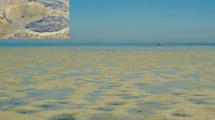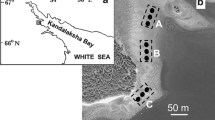Abstract
The recolonization by harpacticoid copepods of patches disturbed by stingrays [Dasyatis sabina (LeSeur)] feeding in a subtidal (2–3 m depth) site off the Florida gulf coast (Lat. 29°54.55′N, Long. 84°31.45′W) was followed. Samples from disturbed patches could no longer be distinguished from control samples in terms of numbers of harpacticoids 29 h after disturbance. No species became significantly disproportionately abundant during the recovery suggesting that small-scale natural disturbances are not an important organizing force in this community.
Similar content being viewed by others
Literature Cited
Barnett, P. R. O.: Distribution and ecology of harpacticoid copepods of an intertidal mud flat. Int. Revue ges. Hydrobiol. Hydrogr. 53, 177–209 (1968)
Boesch, D. F., R. J. Diaz, and R. W. Virnstein: Effects of Tropical Storm Agnes on soft-bottom macrobenthic communities of the James and York estuaries and the Lower Chesapeake Bay. Chesapeake Sci. 17, 246–259 (1976)
Connell, J. H.: Diversity in tropical rain forests and coral reefs. Science, N.Y. 199, 1302–1310 (1978)
Cook, D. O.: Depressions in shallow marine sediments made by benthic fish. J. sedim. Petrol. 41, 577–579 (1971)
Coull, B. C.: Marine flora and fauna of the Northeastern United States. Copepoda: Harpacticoida. Nat. mar. Fish. Circular 399, 1–48 (1977)
Dayton, P. K.: Competition, disturbance, and community organization: the provision and subsequent utilization of space in a rocky intertidal community. Ecol. Monogr. 41, 351–389 (1971)
Grassle, J. F. and H. L. Sanders: Life histories and the role of disturbance. Deep Sea Res. 20, 643–659 (1973)
Hoese, H. D. and R. H. Moore: Fishes of the Gulf of Mexico, Texas, Louisiana, and adjacent waters, 327 pp. College Station: Texas A. and M. University Press 1977
Hollander, M. and D. W. Wolfe: Nonparametric statistical methods, 503 pp. New York: John Wiley and Sons 1973
Holme, N. A. and A. D. McIntyre (Eds.): Methods for the study of marine benthos (IBP handbook No. 16), 334 pp. Oxford: Blackwell Scientific Publications 1971
Howard, J. D. and J. Dorjes: Animal-sediment relationships in two beach related tidal flats; Sapelo Island, Georgia. J. sedim. Petrol. 42, 608–623 (1972)
Howard, J. D., T. Mayou and R. Heard: Biogenic sedimentary structures formed by rays. J. sedim. Petrol. 47, 339–346 (1977)
Kacstner, A.: Invertebrate zoology, Vol. III., 523 pp. New York: Interscience Publishers 1970
Osman, R. W.: The establishment and development of a marine epifaunal community. Ecol. Monogr. 47, 37–63 (1977)
Paine, R. T.: Intertidal community structure-experimental studies on the relationship between a dominant competitor and its principal predator. Oecologia 15, 93–120 (1974)
Paine, R. T.: Disaster, catastrophe, and local persistence of the sea palm Postelsia palmaeformis. Science, N.Y. 205, 685–687 (1979)
Platt, W. J.: The colonization and formation of equilibrium plant species associations on badger disturbances in a tall-grass prairie. Ecol. Monogr. 45, 285–305 (1975)
Rees, E. I. S., A. Nicholaidou, and P. Laskaridou: The effects of storms on the dynamics of shallow water benthic associations. In: Biology of benthic organisms, pp 465–474. Ed. by B. F. Keegan, P. O. Ceidigh, and P. J. S. Boaden. New York: Pergamon Press 1977
Sherman, K. M. and B. C. Coull: The response of meiofauna to sediment disturbance. J. exp. mar. Biol. Ecol. 46, 59–71 (1980)
Simon, J. L. and D. M. Dauer: A quantitative evaluation of redtide induced mass mortalities of benthic invertebrates. Environ. Lett. 3, 229–234 (1972)
Snedecor, G. W. and W. G. Cochran: Statistical methods, 593 pp. Ames: Iowa State University Press 1976
Sousa, W. P.: Disturbance in marine intertidal boulder fields: the nonequilibrium of species diversity. Ecology 60, 1225–1239 (1979)
Thistle, D.: Enhydrosoma (Copepoda, Harpacticoida) an update and two new species. Trans. Am. Microsc. Soc. 99, 384–397 (1980a)
Thistle, D.: The response of a harpacticoid copepod community to a small-scale natural disturbance. J. mar. Res. 38, 381–395 (1980b)
VanBlaricom, G. R.: Disturbance, predation, and resource allocation in a high-energy sublittoral sand-bottom ecosystem: experimental analyses of critical structuring processes for the infaunal community, 348 pp. Dissertation. University of California, San Diego 1978
Wells, J. B. J.: Keys to aid in the identification of marine harpacticoid copepods, 215 pp. Aberdeen: Univ. of Aberdeen Press 1976
Author information
Authors and Affiliations
Additional information
Communicated by J. M. Lawrence, Tampa
Rights and permissions
About this article
Cite this article
Reidenauer, J.A., Thistle, D. Response of a soft-bottom harpacticoid community to stingray (Dasyatis sabina) disturbance. Mar. Biol. 65, 261–267 (1981). https://doi.org/10.1007/BF00397120
Accepted:
Issue Date:
DOI: https://doi.org/10.1007/BF00397120




